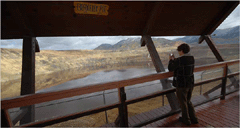
« PREVIOUS ENTRY
The fate of human memory: My latest Wired magazine column
NEXT ENTRY »
Yiiiiiiii

Dig this: A couple of chemists have discovered new breeds of extremophiles — organisms that survive incredibly caustic environments — living at the bottom of an acidic copper-mine pit.
The Berkeley Pit is a copper mine that was abandoned in 1982; it’s 1,780 feet deep and a mile and a half wide. In the last twenty-five years, it has filled with water, and as the water has soaked up the residual arsenic, aluminum, cadmium and zinc, the pond has turned as acidic as vinegar. In 1995, a couple hundred geese landed on the water and instantly died. Nice.
Nonetheless, Don and Andrea Stierl — two chemists who live nearby — wondered if any lifeforms could endure such grim surroundings, so they pulled out some of the pond’s goo and cultured it in Petri dishes. Whaddya know: They’ve found 142 organisms in the muck, and have isolated 80 chemical compounds that exist nowhere else. Better yet, it looks as though some of those compounds might be useful in killing tumors!
As a terrific story in last week’s New York Times pointed out:
Microbes react to harsh conditions in the Berkeley Pit by switching on genes that otherwise lay dormant or by evolving through mutation and natural selection, Mr. Stierle said. Either way, they produce new chemical compounds, which the Stierles hope may benefit human health.
The couple have become intimately acquainted with the personalities of these new microorganisms. The pit’s strain of mycobacterium is a slimy, obstinate fungus that smells bad and is difficult to cultivate in a laboratory. But it has shown initial success in fighting some pathogens, Ms. Stierle said.
Then there is Penicillium rubrum, which is fuzzy and green like bread mold. “It’s sweet, it grows, and this little guy produces large amounts of interesting compounds,” she said. “It’s one of the loveliest microbes we’ve ever worked with.”
This story is a bouquet of all the things I love about science. It offers: a) A couple of total outsiders making discoveries by looking off the beaten path; b) proof once again that, quite apart from the sheer intellectual pleasures of exploring extreme environments, there’s often enormous practical benefits in doing so; c) more evidence that we probably ought to preserve environmentally untouched zones of the Earth, because they probably harbor weird, cool and useful lifeforms; d) an even cooler suggestion that we also ought to be carefully studying the total toxic wreck-dumps left behind by industrial pollution, because, man, who knows, eh?
And best of all, e): Yet more experimental proof that the principle of evolution works precisely as it’s been described for decades.
That picture above, by Lynn Donaldson, beautifully illustrated the Times piece. Go check it out in full-size.
I'm Clive Thompson, the author of Smarter Than You Think: How Technology is Changing Our Minds for the Better (Penguin Press). You can order the book now at Amazon, Barnes and Noble, Powells, Indiebound, or through your local bookstore! I'm also a contributing writer for the New York Times Magazine and a columnist for Wired magazine. Email is here or ping me via the antiquated form of AOL IM (pomeranian99).

ECHO
Erik Weissengruber
Vespaboy
Terri Senft
Tom Igoe
El Rey Del Art
Morgan Noel
Maura Johnston
Cori Eckert
Heather Gold
Andrew Hearst
Chris Allbritton
Bret Dawson
Michele Tepper
Sharyn November
Gail Jaitin
Barnaby Marshall
Frankly, I'd Rather Not
The Shifted Librarian
Ryan Bigge
Nick Denton
Howard Sherman's Nuggets
Serial Deviant
Ellen McDermott
Jeff Liu
Marc Kelsey
Chris Shieh
Iron Monkey
Diversions
Rob Toole
Donut Rock City
Ross Judson
Idle Words
J-Walk Blog
The Antic Muse
Tribblescape
Little Things
Jeff Heer
Abstract Dynamics
Snark Market
Plastic Bag
Sensory Impact
Incoming Signals
MemeFirst
MemoryCard
Majikthise
Ludonauts
Boing Boing
Slashdot
Atrios
Smart Mobs
Plastic
Ludology.org
The Feature
Gizmodo
game girl
Mindjack
Techdirt Wireless News
Corante Gaming blog
Corante Social Software blog
ECHO
SciTech Daily
Arts and Letters Daily
Textually.org
BlogPulse
Robots.net
Alan Reiter's Wireless Data Weblog
Brad DeLong
Viral Marketing Blog
Gameblogs
Slashdot Games